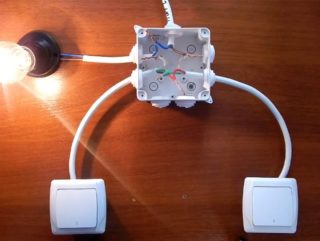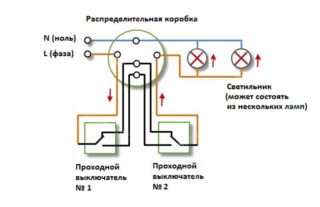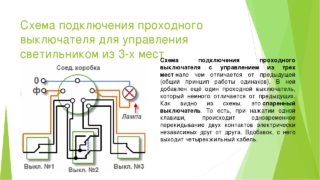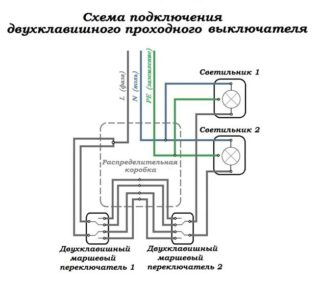To make the adjustment of lighting in the house more convenient, pass-through switches are used, which in professional circles are also commonly called throw-over or duplicate switches. The main difference between this version and the classic one is the presence of a mass of contacts, which makes the connection procedure somewhat more complicated. To do everything with your own hands, first you need a circuit for connecting a pass-through switch from 2 places.
How the pass-through switch works

The pass-through switch has one key on which two arrows are drawn. The circuit of the light switch from two places is somewhat more complicated in comparison with the classical one, since the latter provides for the use of only two contacts, while in the passage there are already three of them, two of which are considered common. The scheme for switching on the light provides for the use of such devices in an amount of two or more.
When the key is pressed, the input is connected to one of the outputs - to the first or the second. These are the two main operating states of such equipment. There are no intermediate positions, due to which the circuit is constantly working properly.
In order not to be mistaken in which switch is used in a particular room, you should study in more detail the circuit of the pass-through switch from two places to 1 light bulb or to several lamps, which in most cases is located on the body of the installed device. It is placed mainly on products from well-known manufacturers. When using inexpensive models, the only solution remains - to "ring" the ends with the help of special equipment.
Contacts are called at different key positions. Also, the procedure is carried out in order to ultimately avoid confusion with the ends, since often irresponsible manufacturers make a mistake in the location of the terminals in the manufacture of switches, which is why the device simply cannot work normally.
To call, you need to use a pointer or digital equipment. The latter is switched to the desired mode with a special switch and determines the presence of short-circuited sections in the tested wiring or some radio components. If you close the ends of the probes, the device will emit a characteristic sound signal, which is a rather convenient principle of operation, since it eliminates the need for constant monitoring of the readings on the display. If there is only a pointer device, when trying to close the probes, the arrow will have to deviate all the way to the right side.
When carrying out this procedure, you need to find a common wire. It will not be difficult for experienced professionals. If you do not have the skills, it is recommended to watch a video on the Internet, which will contain a detailed description of the connection diagram for 2-way switches.
Connection diagram of pass-through switches

The need to connect two bulbs to one switch often arises in the bedroom, when one switch is left near the entrance, and the second is placed somewhere near the bed so that you can conveniently reach it through the light, and then turn it off before going to bed.
The wiring diagram is quite simple: a phase is applied to the input of the switch, the input of the other is connected to the wire of the chandelier.The second end of the chandelier is combined with the neutral wire, and the N1 outputs of both switches are combined with each other in the same way as N2.
The circuit works extremely simply: if any of the switches are switched in random order, the light will turn on and off.
Special attention should be paid to the wiring. Modern requirements provide for the possibility of laying it at a distance of at least 15 cm from the ceiling. It is customary to lay cables in special boxes or trays, and combine the ends in a junction box. This version of the design has a lot of advantages, the main of which is the ease of replacing damaged wires.
In the junction boxes, the wires are connected with special clamps. Twists are also possible, which must be soldered without fail and provided with reliable insulation.
How to connect pass-through switches from three points
To connect lighting according to this scheme, you need to perform several key procedures:
- Connect the neutral wire to one of the cables of the luminaire.
- Connect the phase wire to the input contact of one of the feed-through switches.
- Connect the free luminaire cable to the input contact of the second switch.
- Connect the two input contacts of the crossover switch to the output contacts of the feed-through.
- Connect the output contacts of the second bushing to the output contacts of the cross switch.
Using this scheme in work, you can equip the room with four or five points of lighting adjustment. In this case, it will be necessary to increase the number of additional cross switches, since they must always be located between the checkpoints.
Connecting a two-key pass-through switch
A phase wire is fed to the inputs of each switch, while their other inputs will be connected to one end of each luminaire. The free ends of the luminaires will be connected to the neutral wire. Two outputs of one switch are combined with the outputs of the second, in the same way the remaining pairs of outputs are combined.
If there is a desire to regulate the operation of two lamps at the same time from three or four points, you need to use two cross switches. In this case, each pair of pass-through outputs is connected to a pair of crossover, and then the devices are united in this way pair by pair.
If you understand in detail all the features of connecting pass-through switches, the procedure is very easy to repeat, especially when it comes to connecting single-key devices. When using two-key, the work is much more difficult, as more switches and more wires are used. Moreover, such a scheme in itself is not so practical, but its cost is much higher.
Experts recommend that you only use a two-rocker switch circuit if you really need to. In practice, it is more difficult to connect them and ensure stable operation over time.











Why do the authors redraw a simple scheme into a complex one? In this case, the junction box is not needed at all, the phase is connected to the changeover contact of one of the switches, and zero to the light bulb, the switches are connected to each other with a three-core cable ... That's it!
It is strange, another - why the terminal block was not added to the junction box. Soviet Union Foreva?
Do you live in the Stone Age? Bistable relay and all problems are solved.